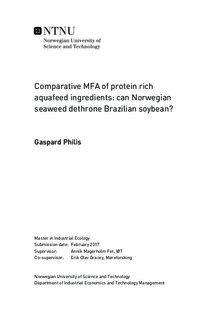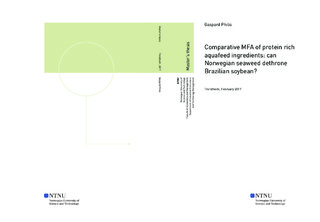| dc.description.abstract | Improving sustainability in agriculture and aquaculture production systems is paramount to global food security and maintaining healthy, diverse ecosystems. One way to reduce pressure on terrestrial food production systems is looking towards the ocean for food production. With its extensive coastline and intensive salmon aquaculture, Norway is experimenting with macroalgae as a new feedstock for a circular bio-economy. The PROMAC research project was launched in 2015 to assess the Norwegian capacity to produce efficiently macroalgal food and feed commodities. This thesis is a part of the environmental analysis performed in PROMAC, and contributes by comparing the environmental performances of two similar aquafeed ingredients: Brazilian Soy Protein Concentrate (SPC) and Norwegian Seaweed Protein Concentrate (SWPC). The efficiency and sustainability of these two production systems is assessed using a comparative Material and Substance Flow Analysis accounting for the transfers of primary energy and phosphorus. While a life cycle assessment study is used to model the cultivation of soybeans in Brazil, cultivation data from a single Norwegian seaweed farm is the primary data input to the seaweed cultivation model. Both systems were modelled with sets of assumptions and generic datasets. To compare commodities with similar protein contents, the primary energy and phosphorus footprints of one ton of SPC is compared to two tons SWPC. The primary energy footprint of SWPC (172,133 MJ) is 11.68 times larger than for SPC (14,733 MJ). However, the SWPC footprint can be reduced to 34,010 MJ by utilizing secondary heat from a waste incineration plant during the late spring harvest. The SWPC system outperformed the SPC system in terms of fossil P footprinting, since one ton of SPC requires 25.75 kg fossil P while two tons of SWPC require as little as 0.008 kg fossil P input. Furthermore, results indicate that, while soybean co-products reduce SPC environmental impacts, SWPC co-product biofertilizers can replace the production of mineral fertilizers at a ratio of nearly 1:1 and reduces the SWPC fossil P -into negative values, -26.36 kg. The overall conclusion of this study is that SWPC holds a competitive advantage based on P management performances, however, replacing SPC will be difficult and require serious innovation and optimization to become energy competitive. | |

